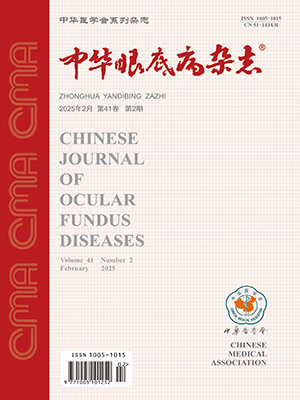| 1. |
Carelli V, La Morgia C, Yu-Wai-Man P. Mitochondrial optic neuropathies[J]. Handb Clin Neurol, 2023, 194: 23-42. DOI: 10.1016/B978-0-12-821751-1.00010-5.
|
| 2. |
Filatov A, Khanni JL, Espinosa PS. Leber hereditary optic neuropathy: case report and literature review[J/OL]. Cureus, 2020, 12(4): e7745[2020-04-20]. https://pubmed.ncbi.nlm.nih.gov/32454526/. DOI: 10.7759/cureus.7745.
|
| 3. |
Chi SC, Cheng HC, Wang AG. Leber hereditary optic neuropathy: molecular pathophysiology and updates on gene therapy[J]. Biomedicines, 2022, 10(8): 1930. DOI: 10.3390/biomedicines 10081930.
|
| 4. |
Ran R, Yang S, He H, et al. A retrospective analysis of characteristics of visual field damage in patients with Leber’s hereditary optic neuropathy[J]. SpringerPlus, 2016, 5(1): 843. DOI: 10.1186/s40064-016-2540-7.
|
| 5. |
Barboni P, La Morgia C, Cascavilla ML, et al. Childhood-onset Leber hereditary optic neuropathy-clinical and prognostic insights[J]. Am J Ophthalmol, 2023, 249: 99-107. DOI: 10.1016/j.ajo.2022.12.014.
|
| 6. |
Kisilevsky E, Donaldson L, Margolin EA. Leber hereditary optic neuropathy with childhood onset producing severe unilateral optic neuropathy with no relative afferent pupillary defect[J/OL]. J Neuroophthalmol, 2023, 43(4): e337-e339[2023-12-01]. https://pubmed.ncbi.nlm.nih.gov/36166811/. DOI: 10.1097/WNO.0000000000001634.
|
| 7. |
Baba T. Detecting diabetic retinal neuropathy using fundus perimetry[J/OL]. Int J Mol Sci, 2021, 22(19): 10726[2021-10-03]. https://pubmed.ncbi.nlm.nih.gov/34639066/. DOI: 10.3390/ijms221910726.
|
| 8. |
Scuderi L, Gattazzo I, De Paula A, et al. Understanding the role of microperimetry in glaucoma[J]. Int Ophthalmol, 2022, 42(7): 2289-2301. DOI: 10.1007/s10792-021-02203-3.
|
| 9. |
Wang D, Liu HL, Du YY, et al. Characterisation of thickness changes in the peripapillary retinal nerve fibre layer in patients with Leber’s hereditary optic neuropathy[J]. Br J Ophthalmol, 2021, 105(8): 1166-1171. DOI: 10.1136/bjophthalmol-2020-316573.
|
| 10. |
Yang S, Yang H, Ma S, et al. Evaluation of Leber’s hereditary optic neuropathy patients prior to a gene therapy clinical trial[J/OL]. Medicine (Baltimore), 2016, 95(40): e5110[2016-10-01]. https://pubmed.ncbi.nlm.nih.gov/27749593/. DOI: 10.1097/MD.0000000000005110.
|
| 11. |
Newman NJ, Yu-Wai-Man P, Carelli V, et al. Efficacy and safety of intravitreal gene therapy for Leber hereditary optic neuropathy treated within 6 months of disease onset[J]. Ophthalmology, 2021, 128(5): 649-660. DOI: 10.1016/j.ophtha.2020.12.012.
|
| 12. |
Arrico L, Giannotti R, Fratipietro M, et al. Fascicular visual field defects in open-angle glaucoma: evaluation with microperimetry[J/OL]. J Ophthalmol, 2016, 2016: 8274954[2016-06-05]. https://pubmed.ncbi.nlm.nih.gov/27366329/. DOI: 10.1155/2016/8274954.
|
| 13. |
Tepelus TC, Hariri AH, Al-Sheikh M, et al. Correlation between mesopic retinal sensitivity and optical coherence tomographic metrics of the outer retina in patients with non-atrophic dry age-related macular degeneration[J]. Ophthalmic Surg Lasers Imaging Retina, 2017, 48(4): 312-318. DOI: 10.3928/23258160-20170329-05.
|
| 14. |
Wang Z, Qi Y, Liang X, et al. MP-3 measurement of retinal sensitivity in macular hole area and its predictive value on visual prognosis[J]. Int Ophthalmol, 2019, 39(9): 1987-1994. DOI: 10.1007/s10792-018-1032-x.
|
| 15. |
Matsuura M, Murata H, Fujino Y, et al. Evaluating the usefulness of MP-3 microperimetry in glaucoma patients[J]. Am J Ophthalmol, 2018, 187: 1-9. DOI: 10.1016/j.ajo.2017.12.002.
|
| 16. |
Longhin E, Convento E, Pilotto E, et al. Static and dynamic retinal fixation stability in microperimetry[J]. Can J Ophthalmol, 2013, 48(5): 375-380. DOI: 10.1016/j.jcjo.2013.05.021.
|
| 17. |
Schönbach EM, Ibrahim MA, Kong X, et al. Metrics and acquisition modes for fixation stability as a visual function biomarker[J]. Investig Opthalmology Vis Sci, 2017, 58(6): BIO268[2017-05-01]. https://pubmed.ncbi.nlm.nih.gov/28973313/. DOI: 10.1167/iovs.17-21710.
|
| 18. |
Igarashi N, Matsuura M, Hashimoto Y, et al. Assessing visual fields in patients with retinitis pigmentosa using a novel microperimeter with eye tracking: the MP-3[J/OL]. PLoS One, 2016, 11(11): e0166666[2016-11-28]. https://pubmed.ncbi.nlm.nih.gov/27893769/. DOI: 10.1371/journal.pone.0166666.
|
| 19. |
McClelland C, Meyerson C, Van Stavern G. Leber hereditary optic neuropathy: current perspectives[J]. Clin Ophthalmol, 2015, 9: 1165-1176. DOI: 10.2147/OPTH.S62021.
|
| 20. |
Ventura DF, Quiros P, Carelli V, et al. Chromatic and luminance contrast sensitivities in asymptomatic carriers from a large brazilian pedigree of 11778 Leber hereditary optic neuropathy[J]. Investig Opthalmology Vis Sci, 2005, 46(12): 4809. DOI: 10.1167/iovs.05-0455.
|
| 21. |
Pan BX, Ross-Cisneros FN, Carelli V, et al. Mathematically modeling the involvement of axons in Leber’s hereditary optic neuropathy[J]. Investig Opthalmology Vis Sci, 2012, 53(12): 7608. DOI: 10.1167/iovs.12-10452.
|
| 22. |
Hwang TJ, Karanjia R, Moraes-Filho MN, et al. Natural history of conversion of Leber’s hereditary optic neuropathy[J]. Ophthalmology, 2017, 124(6): 843-850. DOI: 10.1016/j.ophtha.2017.01.002.
|
| 23. |
Teng D, Peng CX, Qian HY, et al. Structural impairment patterns in peripapillary retinal fiber layer and retinal ganglion cell layer in mitochondrial optic neuropathies[J]. Int J Ophthalmol, 2018, 11(10): 1643-1648. DOI: 10.18240/ijo.2018.10.11.
|
| 24. |
Bianco A, Martínez-Romero I, Bisceglia L, et al. Mitochondrial DNA copy number differentiates the Leber’s hereditary optic neuropathy affected individuals from the unaffected mutation carriers[J/OL]. Brain, 2016, 139(Pt 1): e1[2016-01]. https://pubmed.ncbi.nlm.nih.gov/26209315/. DOI: 10.1093/brain/awv216.
|
| 25. |
Borrelli E, Triolo G, Cascavilla ML, et al. Changes in choroidal thickness follow the RNFL changes in Leber’s hereditary optic neuropathy[J/OL]. Sci Rep, 2016, 6(1): 37332[2016-11-17]. https://pubmed.ncbi.nlm.nih.gov/27853297/. DOI: 10.1038/srep37332.
|
| 26. |
Barboni P, Carbonelli M, Savini G, et al. Natural history of Leber’s hereditary optic neuropathy: longitudinal analysis of the retinal nerve fiber layer by optical coherence tomography[J]. Ophthalmology, 2010, 117(3): 623-627. DOI: 10.1016/j.ophtha.2009.07.026.
|
| 27. |
Newman NJ, Carelli V, Taiel M, et al. Visual outcomes in Leber hereditary optic neuropathy patients with the m. 11778G>a (MTND4) mitochondrial DNA mutation[J]. J Neuroophthalmol, 2020, 40(4): 547-557. DOI: 10.1097/WNO.0000000000001045.
|




